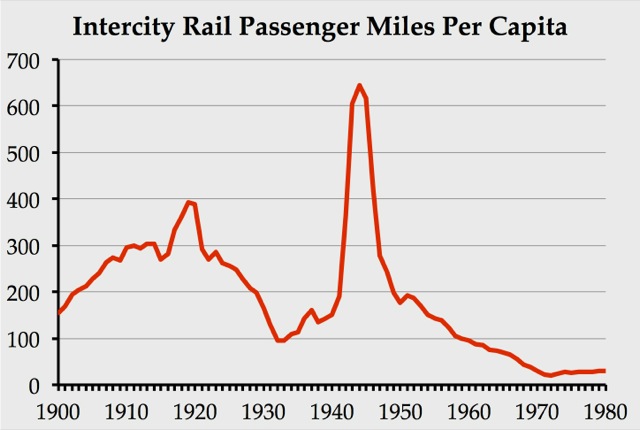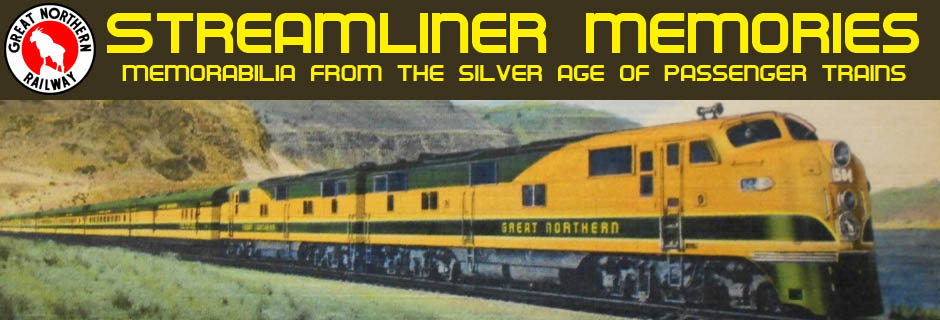Streamlining meant several things to railroad passengers. It meant newer, flashier trains, either stainless steel or painted in bright colors, inside and out. It meant more comfortable trains, with Heywood-Wakefield seats, air conditioning, and large windows for viewing scenery. And, perhaps most important of all, it meant higher speeds, because railroads pushed top speeds to more than 100 mph and/or because Diesel locomotives did not need to make frequent stops for water.

Despite the fact that railroads rapidly introduced new streamlined trains after World War II, revenue passenger miles declined in every year but one between 1944 and 1972. (The one exception, 1951, was probably due to wage and price controls imposed during the Korean War.)
In 1959, Trains magazine editor David P. Morgan wrote his classic article asking, “Who Shot the Passenger Train?” He concluded that the main culprits were archaic labor rules; overly restrictive government regulation; subsidies to airlines and other rail competitors; and unfair taxation of the railroads when government-owned airports and highways did not have to pay such taxes.
As Morgan admitted, all of these impediments applied to freight as well as passenger trains, yet the railroads were able to earn a profit on freight but not on passengers. He responded that, for the sake of justice, all of these problems should be fixed and, if they were, many passenger trains might become viable. Since then, two of the problems–labor rules and government regulation–have been fixed, leading to a huge growth in rail freight traffic. It is easily possible that, if these problems had been fixed earlier, some private passenger trains would have survived longer than they did.
Morgan failed to note, however, one government regulation that affected passenger trains far more than freight: speed limits set by the Interstate Commerce Commission (ICC) in 1947 and that went into effect in 1952. The ICC rules gave railroads a choice of installing automatic train controls or limiting passenger trains to speeds no greater than 79 miles per hour. This speed limit put a severe crimp on railroad efforts to be competitive with automobiles and buses in medium-distance (100-1,000 miles) intercity traffic.
Many sources state that this rule stemmed from a horrific 1946 accident in Naperville, Illinois, that killed 47 people. In that accident, two Burlington trains were moving at about 85 mph with just a three-minute separation between them. The leading train made an emergency stop when a flagman on the train saw something fall off one of the cars. Before the could signal the following train, it slammed into the rear of the first train. Most of the fatalities were in the last car of the first train.
In fact, as the ICC’s own report on the wreck makes clear, this accident was a poor excuse for the ICC rule. If the rule had been in place and the trains were limited to 79 mph, it is unlikely that reducing the speed at the moment of collision by 6 mph would have saved many lives.
Nor would installing the train signals required by the ICC for faster speeds have made any difference. Far from “train controls,” all the ICC demanded was that locomotive cabs be equipped with inside signals that displayed the same lights the crews could see outside the train. If the train passed a yellow signal, a yellow light would turn on in the cab. If the train passed a red signal, a whistle would blow in the cab.
The fireman in the second train of the Naperville accident was killed in the collision, and, strangely enough, the engineer was never asked to testify in any of the many hearings following the accident. However, historian Chuck Spinner points out that “it was not uncommon for the engineer of the trail train to ‘play the yellow,’ or to push the envelope when it came to speed.” In other words, when the crew of the second train saw the yellow signal after the first train stopped, instead of applying the brakes, the engineer merely eased off on the throttle, thinking that first train was still moving but his train had closed the distance between them to slightly less than three minutes. By the time the second train had reached a red signal, the first train was already in sight and the engineer had applied the train brakes. The ICC-required signals would have made no difference.
After the accident, the Burlington changed its operating rules so that high-speed trains would be spaced at least 15 minutes apart instead of just 3 minutes. This would have prevented the Naperville accident as it would have given the flagman of the first train time to go back and signal the second train to stop.
Although the ICC cited the Naperville accident when it imposed the 79-mph speed limit, it had actually been interested in passing such a rule long before 1946. As early as 1922, the ICC had required 49 (later increased to 96) railroads to install cab signals on an experimental basis on at least one district per railroad. After 1952, these districts could continue to run trains faster than 79 mph, but these constituted only about 7 percent of the nation’s mainline rail miles.
Instead of increasing safety, the ICC rule put the brakes on railroad experiments with high-speed trains. The railroads estimated it would cost them $80 million (more than $800 million in today’s dollars) to install the signals. Freight cars spent most of their time in classification yards, so freight trains wouldn’t particularly benefit from higher speeds. The cost of the signals wouldn’t be worth it for the passengers that, in 1950, produced only about 10 percent of the railroads’ revenues.
Rail officials pointed out that, while there had been accidents involving fast streamliners, few would have been prevented by better signals. (For example, two people were killed when a Burlington Zephyr collided with a tractor that had fallen off a freight train on a parallel track just seconds before the Zephyr passed by.)
In response, as a paper by historian Mark Reutter notes, an ICC commissioner said, “When you get to the final analysis here, it is a question of whether you [the railroads] should determine how these funds should be used or whether the government should. . . . And hasn’t Congress given the commission that responsibility?” Yes, and it was only in 1980, when Congress abolished the Interstate Commerce Commission and returned that responsibility to the railroads themselves, that the railroads became revitalized.
On track that did not already have in-cab signals installed, the railroads responded to the ICC rule in one of three ways. The Santa Fe was one of the few railroads to actually install ICC-mandated signals where it wanted to run trains at 100 mph, allowing it to keep its Chicago-Los Angeles streamliners on 39-3/4 hour schedules.
The Burlington was one of several roads that managed to speed up trains where they had been scheduled at less than 79 mph to compensate for having to slow them where they had been exceeding 79 mph, allowing it to maintain its overall speeds and times on such trains as the Twin Zephyrs and Denver Zephyr. Many other roads, however, were forced to add time to their schedules. The Union Pacific, for example, was no longer able to operate the City of Denver and City of Los Angeles as fast as the Denver Zephyr or Super Chief/El Capitan.
With better intercity highways (few of which were subsidized as they were built, operated, and maintained using tolls or gas tax revenues), auto and bus travel was getting faster, as was air travel, of course, as jets replaced prop planes. The ICC rule prevented railroads from competing with these higher speeds. As a result, after 1952, the railroads focused on sightseeing and comforts, rather than speed and convenience, in order to attract passengers. Which brings us to the next step in passenger train evolution: the domeliner.
